Coaching Clinical Teams Module: Facilitator Notes
Slide 1: Coaching Clinical Teams Module

Say:
The Coaching Clinical Teams module helps an organization implement a process for coaching teams as a unit. This module is meant to augment the existing teamwork and communication tools and individual coaching modules of the CUSP toolkit while offering additional strategies to coach teams as a whole. Throughout the module, best practices from the ambulatory surgery setting are highlighted.
Slide 2: Objectives

Say:
Today we are going to talk about how to coach clinical teams to improve their performance. This is not about coaching technical skills in a clinical setting but instead coaching how to better function as a team.
This module has several objectives. By the end of this presentation, you should be able to—
- Understand how clinical teams are currently trained in the health care setting and how coaching can help.
- Describe coaching in the clinical environment.
- Outline benefits of coaching in the health care setting.
- Identify the characteristics of a good coach.
- Demonstrate the steps a coach should follow when giving feedback to a team.
- Describe how an observation tool can improve a coach's performance.
Slide 3: Overview

Say:
This module discusses coaching and how it can be used in the clinical setting.
It will first give an overview of coaching and teaching in the health care setting.
Next, we will discuss techniques that you can use to give constructive feedback to a team.
Finally, we will discuss how to put coaching into action and how observation tools can help you be a successful coach.
By the end of this presentation we will have walked through all of the things you need to think about when coaching clinical teams. This will include many topics from picking the appropriate people to be coaches, to outlining how to give feedback in a way that helps team members gain insight into their behaviors, and to promoting a better functioning team.
Slide 4: Coaching Defined

Say:
Let's begin with an overview of coaching.
This section covers the standard approach to teaching in the health care setting.
We will discuss a different way to change behavior in the health care environment by coaching teams to improve.
We will provide an overview of coaching in the health care setting and its benefits.
Finally, we will describe the characteristics of a good coach and discuss when to coach clinical teams.
Slide 5: Standard Approach to Training in the Health Care Setting

Say:
Let's look at how training is typically given in the health care setting.
When we want someone to do something differently, we usually gather a committee to create a manual or procedure guide. This is done in isolation without the input of those who will receive the training.
Then, PowerPoint presentations present the information as training, and people are expected to change and use that procedure or policy in their practice. There is very little followup, and we wonder why things do not always get better.
Slide 6: Applying Health Care Training to Driving Instruction

Say:
In comparison, let’s think about how we teach people to drive a car, and let’s model it after standard training methods in health care.
If we taught someone to drive this way, we would give them a driver’s manual and show them a PowerPoint presentation about driving. Then we would give them the car keys, show them the freeway, and expect them to be able to drive.
This is not a good way to teach someone to drive.
Slide 7: How We Really Teach Someone To Drive

Say:
By contrast, this is how we actually teach someone how to drive.
We give them a driver's manual to read and a PowerPoint presentation to learn from. But then we do more.
We introduce the person to the car so they understand how the car works before they ever drive. Then, we have them drive with a coach by their side before they go out on their own.
Coaching and practicing are critical pieces of teaching someone to drive. Don't you think that coaching and practicing should play a similar role in health care?
Slide 8: An Alternative Approach to Teaching in Health Care – Coaching

Say:
When training individuals and teams in the health care setting, we can use the approach of teaching someone to drive. This image shows how we might break down this new approach.
First you teach and show health care providers how to apply the new guidelines, tools, or care practices.
Then you have a coach watch the individual or team use the new guidelines, tools, or care practices and give constructive feedback to improve the team's performance.
All these steps together are coaching.
Slide 9: Overview Of Coaching

Say:
Now we will describe coaching in more detail.
Coaching involves listening, watching, and asking questions about what you see and hear. Asking questions helps you understand the team's actions and learn from the team.
Additionally, coaching involves getting teams to reflect on their behavior and actions and to understand how they can improve their performance.
Slide 10: Overview Of Coaching (continued)

Say:
In contrast, it is important to understand what coaching isn't. Coaching isn't telling the team what to change. Coaching isn't criticizing the team for what it did.
These are all examples of one-way communication, whereas the points on the previous slides involve two-way communication through listening, asking, and reflection. Coaching isn't a way to instruct or teach a team how to do things. One of the most important parts of coaching is that it is an interactive method to support individuals and teams.
Slide 11: Benefits of Coaching Teams

Say:
What are the benefits of coaching teams? Studies have shown that coaching can lead to better patient care. Coaching can improve the morale of the team and ultimately lead to a better functioning team because everyone is on the same page about ways they can improve their performance.
Finally, coaching can help identify safe practices you want to spread to other teams, and it also can help identify areas on which to focus your quality improvement efforts.
Slide 12: Traits of a Coach

Say:
When we talk about effectively coaching clinical teams, we need to consider who should be the coach. Not everyone can coach, and not everyone should coach.
A good coach is someone who also is coachable. If someone’s own behavior is not changeable through coaching, that person likely does not have the characteristics required to be successful in changing the behavior of others. If I am not willing to be watched and answer questions about my own job to get feedback myself, then I shouldn’t be coaching other teams.
A coach should be someone who peers trust and respect. If a person is being coached by someone they don’t trust or respect, they are probably not going to be as willing to listen to that person as a coach.
A coach should be an excellent communicator and someone who respectfully listens to others.
A good coach is knowledgeable in the clinical environment, which helps the coach understand what the team is doing and why. While the coach doesn’t have to be a clinical expert in the area that they are coaching, they do need to be knowledgeable about the clinical environment and understand how team members work together and communicate to accomplish the task at hand. If the coach gives inappropriate coaching in a clinical area, staff will know the coach is not authentic and may not trust or respect his or her opinions related to team performance and coaching.
Finally, a good coach understands how to give feedback. In being coachable, the coach understands how to receive feedback. However, an effective coach needs to understand how to give constructive and nonthreatening feedback. Being able to give feedback and giving appropriate feedback are important qualities, but listening is a key component. The remainder of the presentation will focus on how to coach.
Slide 13: Giving Constructive Feedback to Teams

Say:
Now that you understand what coaching is and who makes a good coach, we will focus on how to give constructive feedback to teams and some techniques you can use as a coach.
We will start this discussion by talking about how feedback is often given in the health care environment. We will talk about some basic rules to follow when giving feedback.
We will then talk about how to give feedback to teams by asking questions.
We will end this portion of the presentation by discussing some specific examples of coaching the team by asking questions.
Slide 14: How Feedback Is Often Given in the Health Care Setting
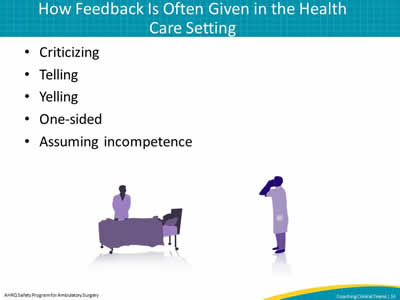
Say:
Here is how feedback is often given in the health care setting and what you should avoid as a coach.
Feedback is often given by criticizing people, telling them what to do, and yelling at them.
Frequently, feedback is given in one direction: to the recipient. In this typical approach to giving feedback, a subtle message is sent to the recipient that they are incompetent. Poor coaching occurs when the coach assumes that the teams they are coaching are incompetent when, in reality, most of the teams that they are coaching in health care are experts at their jobs.
Good coaching on the other hand tries to avoid these things and is bidirectional. We will show you techniques to provide feedback to teams later in this presentation.
Slide 15: Key Components of Feedback
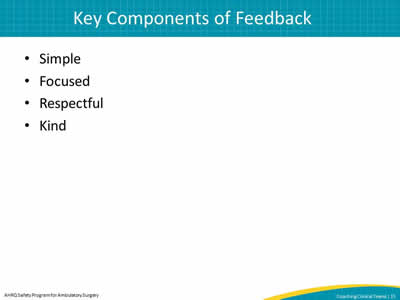
Say:
Here are some things to remember when coaching a team.
When giving feedback, it important to keep it simple. Complex feedback is difficult to understand. If the message is simple, the chance is higher that it will be well received.
Keep your feedback focused on a specific behavior. Avoid generalizations and do not coach a particular person; coach the team. It is better to focus on what you are trying to coach with a statement like, “I noticed the team members did not introduce themselves prior to starting this surgical procedure” rather than saying, “There was no communication in this room prior to the case.” Additionally, be sure that your focus stays on the team’s behavior instead of singling out one person. For example, instead of saying, “I noticed that the surgeon and the anesthesiologist did not contribute to your team discussions,” it may be better to note that “it doesn’t seem like everyone on the team contributed to the team discussion.”
You want the team receiving your feedback to accept it. If you want your feedback accepted, you need to be respectful. Remember when you are coaching a clinical team that the team came to work to help others. As a coach, we are working to help them do an even better job. Effective coaches must treat their colleagues respectfully.
Finally, be kind when giving feedback to teams. This is an extension of being respectful. Kindness in the way the feedback is delivered keeps recipients from being defensive. For example, it would be more helpful to hear, "There may be an opportunity to improve" rather than, "Your team is so bad, and you need to change everything."
Slide 16: Coach by Asking Questions

Say:
When you deliver coaching to a team, the most effective way is to ask the team a series of questions. Remember, you are coaching knowledgeable adults, and you want the team members to analyze the situation for themselves without telling them the answers. Ideally, team members do this by reflecting on what has happened. You can use questions to help the team do this. You also want team members to analyze the situation so they find their own solutions, if possible. Your questions can help guide the team to determine the solution, as opposed to you telling the team what to do. The role of you, the coach, is to guide, not to tell.
One of your goals as the coach is to have the light bulb to go on so team members understand what they could have done to improve their performance. If you follow these guidelines, the team owns the process of improving care delivery for the next time rather than you telling them what they should do to improve their performance.
Slide 17: Components of the Three-Part Question

Say:
When you use questions to give feedback, it is best to use a three-part question.
This technique begins with your observation. Next comes your opinion on why you think your observation is important Finally, you may ask your question to help the team reflect on reasons for its actions.
Using the three-part question will help you give constructive feedback that will encourage the team to reflect on what happened and propose their own solutions.
This three-part question will also help you follow the guidelines we outlined by providing simple, focused, respectful, and kind feedback while avoiding telling, criticizing, and instructing or teaching.
In the next few slides we will dive into each one of these components so you can understand this technique better.
Slide 18: Part I: Your Observation
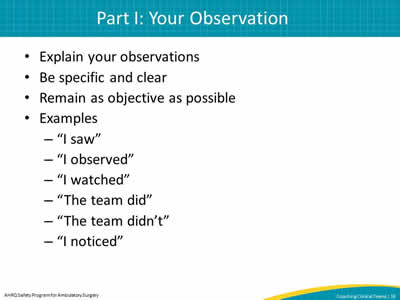
Say:
Let’s look at each part of the question individually.
Part one is your observation. This is your chance to tell the team what you saw. It is important to be specific, clear, and objective.
You want to present back to the team exactly what transpired that raises your concern or prompts your encouragement. This helps the team focus on a specific action or behavior.
There are several ways to say this:
- "I saw"
- "I observed"
- "I watched"
- "The team did"
- "The team didn't"
- "I noticed"
Remember to stick to the facts of what you saw, and stop short of telling people why you think the team did what they did. For example, say "I saw that you did not check the specimen label" or "The team didn't debrief at the end of the case."
Slide 19: Part II: Your Opinion

Say:
Part two is your opinion. This is where you state why you think what you saw is important to talk about as a coach and to explain why you pointed out what you did.
You can use several phrases to express this:
- "I think…"
- "I believe…"
- "It is really important to…"
- "I am pleased because…"
- "I am concerned because…"
Note that this is NOT your opportunity to give your opinion about why you think something happened. Instead, this is about pointing out why you chose to discuss something that happened.
For example, it is better to say "I think a debrief is really important because…" rather than saying "I think you all didn't debrief because…" Phrasing the question this way does not give an answer but instead provides an opportunity for reflection.
Slide 20: Part III: Your Question

Say:
Finally, part three is your chance to ask a question to help the team reflect on what happened. If worded properly, it should help the team understand why you were concerned about what you saw. The question should express genuine curiosity about what happened. Being openly curious lets the team know that the coach is sincere and truly wants to understand what the team thinks. Being curious also lets the team know that the coach is open to learning from them and doesn't have all of the answers.
Here are some ways to express this:
- "Can you help me understand?"
- "I am curious, what do you think happened?"
- "How did that make you feel?"
- "What is your point of view?"
- "How did you experience that?"
- "I wonder what you think happened?"
- "Where do you think your team was coming from?"
Slide 21: The Three Parts Together

Say:
To use this technique effectively, put the three parts together.
Here is an example: “I noticed the team did not debrief at the end of the case. I think debriefing is really important. Can you help me understand why that didn’t happen?
Later in the presentation we will show you a video clip of a coach giving feedback to a team using the three-part question.
Slide 22: Avoid Making Generalizations

Say:
We will now discuss how using the three-part question can help coaches avoid giving negative feedback.
First, avoid making generalizations. For example, a generalization might be: “I noticed that communication wasn’t very good. I think that having good communication is important. Can you help me understand what happened?”
Instead, give the team examples of what you saw. You might say something like: “I noticed your team didn’t use the checklist on the wall to prompt your discussions. I believe reading off of the checklist helps so that all items on the checklist are discussed. I’m curious why you didn’t read the items aloud.”
Instead, give the team examples of what you saw. You might say something like: “I noticed your team didn’t use the checklist on the wall to prompt your discussions. I believe reading off of the checklist helps so that all items on the checklist are discussed. I’m curious why you didn’t read the items aloud.”
Slide 23: Avoid Assuming You Understand People’s Actions

Say:
Avoid assuming you understand people’s actions. For example, do not say: “I noticed you skipped the introductions because you were in a hurry.”
Instead you might say: “I noticed your team skipped introductions. I think they’re an important part of the checklist because they give everyone a chance to say something before the start of the case. Can you tell me why you skipped them?”
You might have a tendency to fill in the blanks and try to explain what you saw, which may not be the most accurate explanation. Using the three-part question lets the team explain its actions.
Slide 24: Avoid Making the Team Guess What You Are Thinking
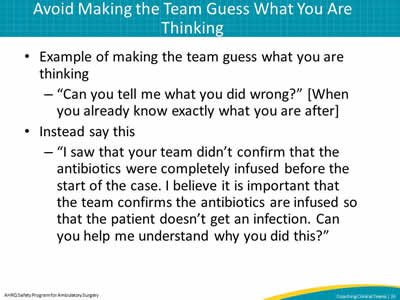
Say:
Avoid making the team guess what you are thinking.
For example, “Can you tell me what you did wrong?” is not a helpful question during coaching. The team members should not be quizzed but rather supported.
Instead, say something like: “I saw your team didn’t confirm that antibiotics were completely infused before the case started. I believe it is important that the team confirms the antibiotics are infused so that the patient doesn’t get an infection. Can you help me understand why you did this?”
This is another example of how using the three-part question keeps you as the coach from asking questions you already know the answer to.
Slide 25: Avoid Asking Questions That Already Contain the Answer
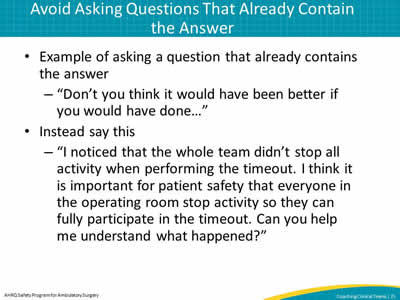
Say:
Avoid asking questions that already contain the answer, such as: "Don't you think it would have been better if you would have done…"
Let the team determine improvements on its own, as mentioned earlier.
Instead, say something like: "I noticed the whole team didn't stop all activity when performing the timeout. I think it is important for patient safety that everyone in the operating room stops activity so they can fully participate in the timeout. Can you help me understand what happened?"
Slide 26: Avoid Disguising a Statement as a Question

Say:
Avoid disguising a statement as a question. Do not say something like, “You didn’t really want to do that, did you?”
Instead say: “I saw your team didn’t review the specimen labeling before the patient left the room. I believe it is important to read back the specimen labeling, including the patient’s name, so there is no confusion over what the specimen is. I’m curious, what do you think happened?”
Slide 27: Avoid Singling Out Individuals When Coaching the Team
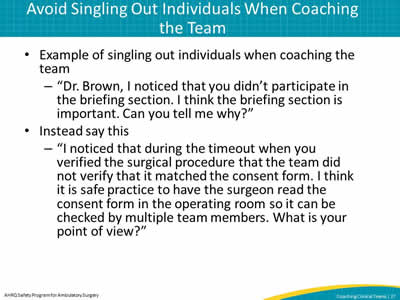
Say:
Finally, avoid singling out individuals when coaching a team. As mentioned earlier, any coaching of individuals should be done one on one and away from the team so each team member receives respectful attention.
Do not say something like, “Dr. Brown, I noticed you didn’t participate in the briefing section. I think the briefing section is important. Can you tell me why you didn’t participate?”
Instead, say something like, “I noticed during the timeout when you verified the surgical procedure that the team did not verify that it matched the consent form. I think it is safe practice to have the surgeon read the consent form in the operating room so it can be checked by multiple team members. What is your point of view?”
Slide 28: Putting Coaching Into Action

Say:
Now that you understand how to formulate your feedback using a three-part question and how the three-part question helps coaches avoid giving negative feedback, let’s see how to put coaching into action.
In this section we will discuss planning and scheduling coaching sessions with health care teams.
We will also discuss when the best time to give feedback to teams is.
Then we will bring together all the steps a coach should follow. These include: setting the stage at the beginning of a coaching session and asking a question to start, giving feedback with the three-part question, motivating the team toward the end of the session, and ending the coaching session.
Slide 29: Planning Your Coaching Day

Say:
When planning your coaching sessions, it is best to start your planning by thinking about which teams you should observe and coach. When trying to identify a team to coach, start with teams that are receptive and open to feedback. Some teams are not ready for coaching. Openness ensures the team will listen to your feedback and develop a plan for improving its performance.
Coaching is also better received when team members are not under unusual stress. It is important to try to observe in cases that are likely to be routine procedures, particularly for newer coaches. If a case is expected to be complicated, the stress level may be higher and it may not be a good time to coach. For example, it may not be best to coach a team during an emergency case.
It is also important to coach teams on days when they will have time to talk about their performance. The best way to make sure there is dedicated time to talk with the team is to schedule a meeting ahead of time or to coach on a day when the team has a lighter caseload and is not pressured for time.
It is best to meet with the entire team to coach, but sometimes this isn’t practical. If you can’t meet with the entire team, try to coach as many team members as possible or talk to people individually about the team’s performance. Remember that you can still coach the team’s performance even when you are in a one-on-one setting.
Before you observe the team, it is important to explain that you are observing them to learn and that the ultimate goal is to improve their performance as a team.
Slide 30: When To Coach in the Clinical Setting
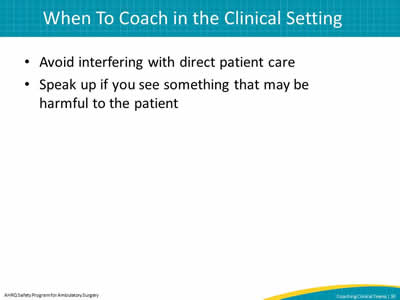
Say:
Here are some basic guidelines on when to coach.
Coaching should never interfere with direct patient care. If you are observing a team in a clinical setting, it is safe practice to wait to coach until after the team has completed the patient care.
However, if the team is involved in a patient safety event, it would be appropriate for the coach to speak up. If something harmful to the patient can be avoided, the coach should say something and not let it happen.
Slide 31: Questions Coaches Need To Ask Themselves Before Coaching The Team’s Performance

Say:
Before you give feedback to the team, ask yourself these questions.
First, what is the team doing? Provide feedback to the team at a time that does not interfere with patient care, and try to provide feedback at a time when as many team members as possible are present.
The second question to ask yourself is, “Do I need to coach an individual or a team?” If you are coaching an individual, give feedback one on one to avoid singling out the individual in front of the team. If you are trying to improve the performance of the entire team, it is appropriate to coach the team together.
It is also important to ask yourself if coaching will be effective for this team. You should do your best to observe in cases where you think the team will be open and receptive to feedback, though you may not have a clear understanding of team dynamics until you have had a chance to watch the team. Team members need to be open to hearing constructive feedback.
Finally, think about what happened during the case and if the team is unusually stressed. Events that occur during the course of the case may make it inappropriate to coach. You may want to reconnect with the team at a later time.
Now let's talk in depth about the steps to take as a coach when giving feedback to the team.
Slide 32: Giving Feedback to the Team: Step 1 – Setting the Stage

Say:
Once you have determined that it is an appropriate time to give feedback to the team, the first step is to set the stage.
Start the session by thanking the team for allowing you the privilege of observing them while they were working. This starts the coaching session in a respectful way.
Then frame the coaching session by letting the team know that the purpose of the session is to improve patient care by continually improving the team's performance.
This video shows an example of a coach setting the stage.
Note: This slide includes a video. If you have trouble accessing the video on this slide, it is also available at: https://youtu.be/hk-3S5sQVmQ
Do:
Play video.
Ask:
Was there anything the coach could have done better to set the stage for coaching?
Slide 33: Giving Feedback to the Team: Step 2 – Start With an Open-Ended Question

Say:
When you start your session, it is important to begin with an open-ended question, such as, "How did the last case go?" This opens the door for team members to say what is on their minds so you can take the conversation where you think it should go. Starting with an open-ended question allows the team to decompress and discuss what went well or any problems.
This video shows an example of a coach starting off the coaching session with an open-ended question.
Note: This slide includes a video. If you have trouble accessing the video on this slide, it is also available at: https://youtu.be/9C1cvna5NAg
Do:
Play video.
Ask:
Did you notice that the coach started with an open-ended question to the team? What do you think about starting a coaching session with an open-ended question?
Slide 34: Giving Feedback to the Team: Step 3 – Share Observations Using the Three-Part Question
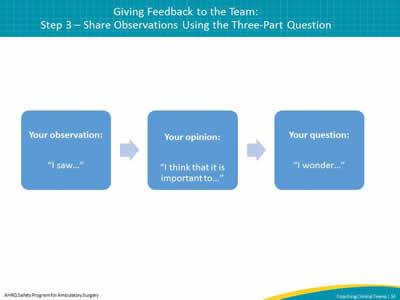
Say:
Next the coach should focus the team on specific behaviors that were positive or those behaviors the team could improve.
It may be helpful to first focus on a positive behavior to open the team up to further coaching. This is where the coach should use the three-part question.
Part 1 – State your observation: “I saw…”
Part 2 – State your opinion: “I think that it is important to...”
Part 3 – State your question: “I wonder...”
Slide 35: Coaching Using Three-Part Question
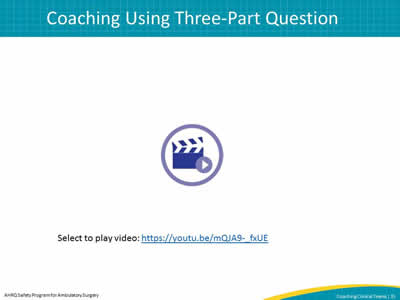
Say:
This video shows an example of a coach using the three-part question to facilitate discussion.
Note: This slide includes a video. If you have trouble accessing the video on this slide, it is also available at: https://youtu.be/mQJA9-_fxUE
Do:
Play video.
Ask:
Did the coach in the video state his question in three parts including his observation, his opinion, and finally his question?
Say:
There are also tools that may be helpful to use when giving feedback to teams. An example is AHRQ's Learn From Defects Tool. This tool can be helpful in facilitating a discussion between team members.
Slide 36: Giving Feedback to the Team: Step 4 – Motivate the Team by Focusing on What It Could Do Better

Say:
Here is a technique to help the team find its own solutions to improve performance.
During the coaching session, motivate the team by helping members focus on what they can do better. This two-part technique first requires the team to discuss what went well. Afterward, the team identifies opportunities for improvement and discusses how to implement improvements.
This technique is about the team focusing and reflecting on what it did and how to better its performance.
Let’s look at an example of how this can be done in the health care setting.
Slide 37: Motivating the Team
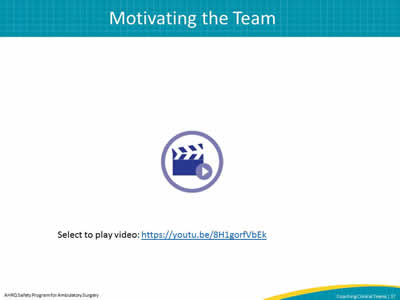
Say:
This video shows the coach motivating the team by asking what went well and how the team can improve in the future.
Note: This slide includes a video. If you have trouble accessing the video on this slide, it is also available at: https://youtu.be/8H1gorfVbEk
Do:
Play video.
Ask:
How did the coach motivate the team? Did team members identify what went well and opportunities for improvement on their own?
Slide 38: Giving Feedback to the Team: Step 5 – Ending the Coaching Session
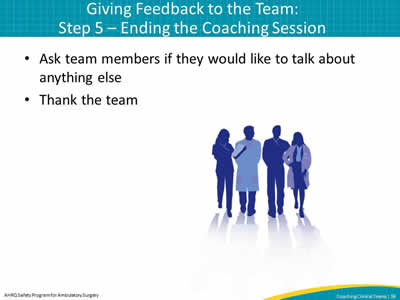
Say:
At this point, we can end the coaching session.
Most of the time, it is best to ask team members if they want to talk about anything not covered in the coaching session. This gives them permission to present issues still on their minds.
Finally, just as you thanked the team in the beginning of the coaching session for the privilege of letting you observe, thank the team for the privilege of coaching to better its performance as well as for taking the time to talk with you.
Now let’s watch ending the coaching session in action.
Slide 39: Ending the Coaching Session

Say:
This video shows an example of a coach ending a coaching session.
Do:
Play video.
Ask:
How did the coach end the coaching session? What key elements did the coach cover as he ended the session?
Note: This slide includes a video. If you have trouble accessing the video on this slide, it is also available at: https://youtu.be/88t46tAXUVE
Slide 40: Observation Tools as Coaching Resources

Say:
Using an observation tool when coaching teams can help you develop feedback.
In this section we will cover why using an observation tool is helpful when coaching, how to use an observation tool, and useful resources.
Slide 41: Benefits of Using an Observation Tool
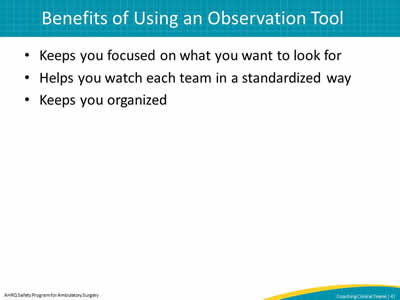
Say:
Using an observation tool when coaching can help you focus on behaviors to look for during a case and determine if they are missed.
It also provides some standardization to your observations between teams, and can help keep you organized.
Slide 42: How To Use an Observation Tool

Say:
Using an observation tool during the case can have a negative connotation.
Some members of the team may feel like you are conducting an audit. A way to avoid this is to tell the team at the beginning of the case or beforehand that you will be using an observation tool to help you and that it is not being used for auditing purposes.
It is also important to tell team members that the tool is for internal use, and its purpose is to improve team performance. Make sure teams do not feel like they may be penalized. You want the team to be open to improving their performance.
The observation tool can be filled out during the case or immediately after to help you remember the specifics of what happened during the case.
Finally, avoid using personal identifiers for team members on the observation tool. Respecting the confidentially of the feedback is important to having team members be open to your coaching and trust you.
Slide 43: Summary

Say:
This presentation described many important concepts around applying coaching in the health care setting.
Coaching can help ensure improvements in patient care become a standard of practice for every patient every time.
Coaching can be applied successfully using the coaching model outlined in this presentation. We need to remember that one of the keys to successful coaching is picking the appropriate coaches and training coaches on how to give constructive feedback in a way that spurs team self-reflection.
It is important to plan your coaching sessions in advance. When coaching in the health care setting, the coach should observe only when the team is not under unusual stress and schedule time to talk to the team and provide feedback.
Finally, use an observation tool to focus on particular behaviors and provide specific feedback.
Slide 44: Tools
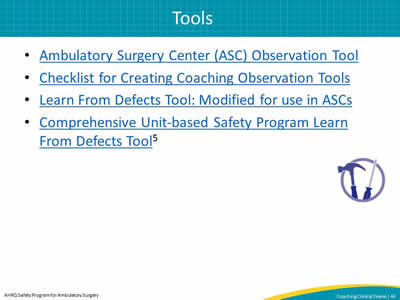
Say:
In addition to the information presented in this module, some tools might help. These include—
- The ambulatory surgery center observation tool
- The checklist for creating coaching observation tools
- The Learn From Defects tool modified for use in ASCs
- The Comprehensive Unit-based Safety Program Learn From Defects Tool
Slide 45: References

- TeamSTEPPS Fundamentals Course: Module 9. Coaching Workshop: Instructor's Materials. November 2008. Agency for Healthcare Research and Quality, Rockville, MD.
- Knight J. Coaching: The key to translating research into practice lies in continuous, job-embedded learning with ongoing support. Journal of Staff Development. 2009 Dec 1;30(1):18-22.
- Rudolph JW, Simon R, Rivard P, et al. Debriefing with good judgment: combining rigorous feedback with genuine inquiry. Anesthesiol Clin. 2007 Jun;25(2):361-376. PMID: 17574196.
- Marilyn, PC, Moore Joseph. Learning in the thick of it. Harv Bus Rev. 2005 Jul-Aug;83(7):84-92, 192. PMID: 16028819.
- Learn From Defects Tool. CUSP Toolkit. December 2012. Agency for Healthcare Research and Quality, Rockville, MD.



